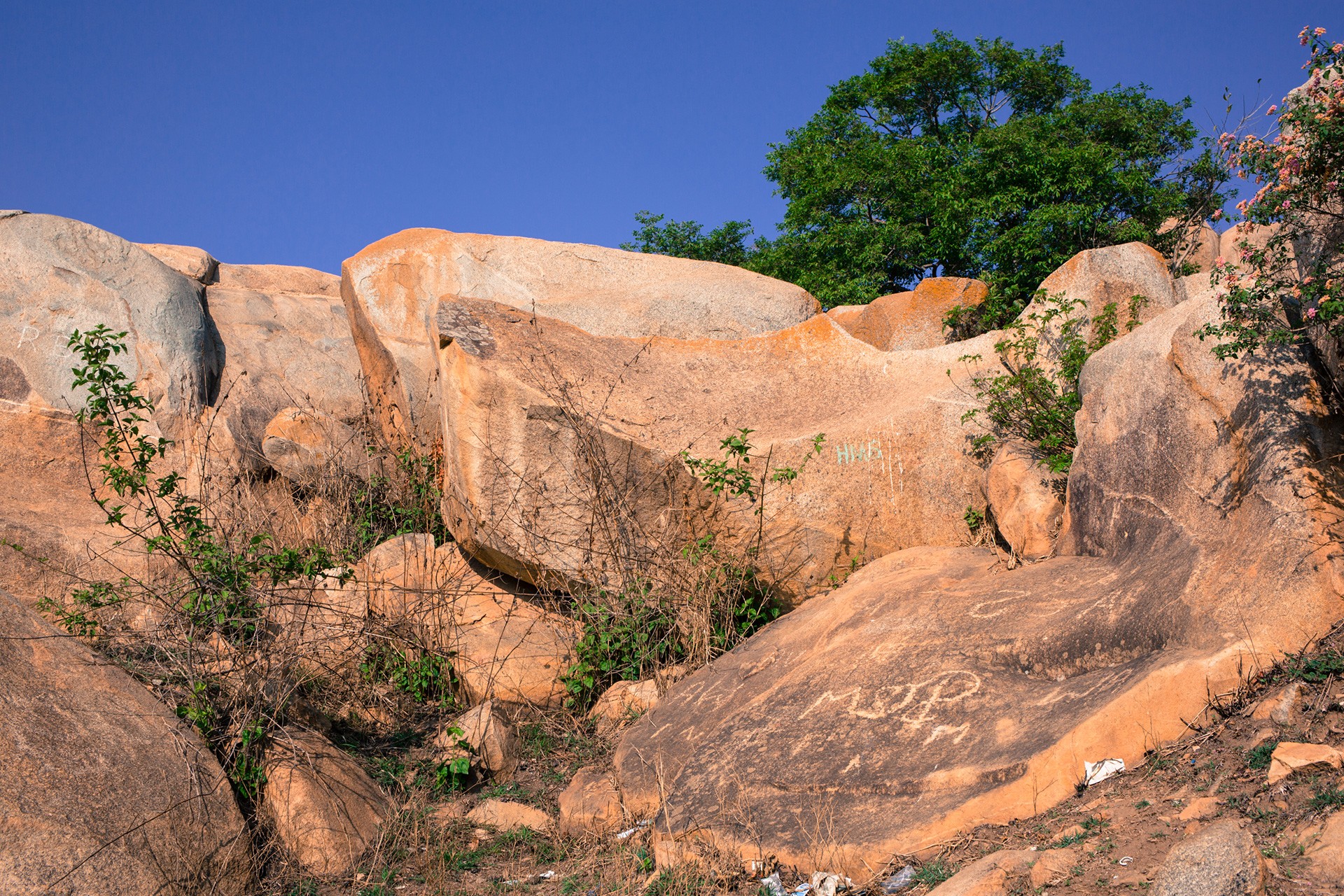I looked down to check my footwear. These boots certainly weren’t made for walking, but I’d make do. Vivek Muthuramalingam, the accompanying photographer, and I were about a kilometre away from the highest point in Bengaluru in a suburb called Chikkabettahalli, which literally translates to ‘small hill village’.
A couple of weeks ago, Sharath Nayak, one of the architects at Biome Environmental Solutions had mentioned to Vivek that the highest natural point in Bengaluru was very close to their office near the Vidyaranyapura bus stop (about 4 km from Yelahanka New Town). Curious, we decided to see the place for ourselves.
We started walking on the main road and turned into a side street lined by a mosque, butcher shops and assorted buildings in various states of disrepair. Groups of school children passed us, lugging their backpacks. Old men sat reading Kannada newspapers under trees, and the occasional puff of beedi smoke wafted towards us. Nearly all the houses stood open; women in nightgowns stood in the doorway chatting with their neighbours, waving goodbye to their kids skipping away to school, sweeping the entryway.
Without warning, the lane bent by a good 60 degrees and Vivek and I stopped in our tracks. The highest natural point in Bengaluru was a hillock. A small one, admittedly, but a 50-feet-high hillock.
It was primarily granite, the sharp cuts on its side clear evidence of quarrying. Dusty green scrub trees grew upon it and a lone Pariah Kite circled above. We continued on a rough-hewn, dusty path, passing a well half-filled with murky black water, a few gravestones that lay forlorn in a depression in the ground, a temple and its priest. All we could hear was the distinct sound of quarrying in the distance, ironically interspersed by strains of school children’s voices raised in a spirited rendition of ‘Jaya Bharata Jananiya Tanujate’, Karnataka’s official song praising the natural beauty of the state, their volume rising and falling with the wind.
The hill’s rocky surface felt warm to the touch in the early morning sun, its base littered with a few plastic bottles, empty chips packets and newspaper sheets. I spotted a cavern of sorts, created by the rocky outcrop, the sharply cut granite clear evidence of quarrying, scratched with lovers’ initials and assorted graffiti. We continued walking around the hill, the jagged rocks giving way to a smooth, rounded surface, untouched by machinery. Cement steps made their way into a nook housing a Someshwara idol halfway up the back of the hill.
Not to be deterred, we finally found a way up. A few dogs stood at various points on the hill, resembling sentries guarding their fort. Vivek, the intrepid trekker, climbed up with the agility of a mountain goat. I, the intrepid beanbag-inhabitor, followed with all the grace of a lumbering Giant Panda. We neared the top of the hill and I stopped short. The smooth curve of the highest rock intimidated me, but Vivek continued on. Before I could catch my breath, he returned with the same speed. “Too many dogs sunning themselves up there, I didn’t want to take a risk,” he muttered.
We stood on the ledge for a while, soaking up some Vitamin D.
Bengaluru stretched out before us as far as we could see, high-rises glinting in the sun, half-constructed tall buildings casting grey shadows on the houses around them, while the smaller ones lay like brightly coloured jewels.
All green seemed grey, thanks to the haze.
Our priest of earlier in the hour met us after our climb down. Enquiring about our business in the area, he got chatting with us about Chikkabettahalli. Once, all you could see around here were farms, but most farmers sold their land for development in “Indira Gandhi’s time”. Urbanisation, coupled with quarrying in the area, altered the landscape dramatically. The construction of the new airport close to Yelahanka brought Chikkabettahalli within city limits. The hill, he said, shaking his dreadlocked head, used to be much bigger. Apparently, a good portion of it was quarried away before the residents went up in arms against it, thanks to the presence of the Someshwara idol on the hill. However, quarrying in the rest of the area continued to this day, also the designated dumping of construction debris.
An abandoned quarry, I realised, that’s what this was. And the only reason it was abandoned was religious. Either way, whatever could be quarried without actively hurting sentiments had clearly been taken away.
We strolled towards the cluster of houses and were met by smiling women who gave us water and gossiped with us. A little distance away, a patriarch held court. Syed Gaffar sat on a stone bench in front of his house, surrounded by his wife, daughter-in-law, grandchild and son. Clad in pristine white, the 65-year-old proceeded to reminisce about the childhood he spent running about the hills with his cousins. “Hills? Was there another one around here?” asked Vivek. Gaffar nodded, and told us of Doddabettahalli, the adjacent area (literally ‘big hill village’), and how his grandfather came here from Dindigul, Tamil Nadu, to farm. The land was covered in fields in those days – mostly ragi and pulses. Slowly, they sold their land and took up other work “in the city”. Most of his progeny still resided in the locality.
“Doddabettahalli had a big hill – much bigger than this one here. You could see the whole of the city from the top. The Army used to have an outpost there,” he said.
“How did an entire hill vanish?” I wondered.
“Quarrying,” he replied, and I remembered looking up a map of the area early that morning and finding a quarry close by. A quick Google search told me the hill in Doddabettahalli used to be 962m high.
He then posed for photos while his wife rolled her eyes in familial disdain. Amused, Vivek and I said our farewells. “I’m going to come here again with trekking shoes,” said Vivek. “I’m going to come here again after a month in the gym,” I wheezed back, though to be perfectly honest, it was much too deserted (not to mention those dogs standing guard) for me to return for leisure.
The hill in Doddabettahalli used to be 962m above sea level. According to Sharath, Google Earth elevations show the Chikkabettahalli hillock to be two-feet lower than Doddabettahalli.





